FIELD: chemistry.
SUBSTANCE: present invention relates to an elastomeric polymer composition and preparation thereof. Described is a polymer composition for producing cross-linked rubber compounds containing modified polymers according to following Formula 1 and Formula 2:
 Formula 1
Formula 1
 Formula 2,
Formula 2,
where P1 and P2 each independently represents a polymer chain obtained by anionic polymerisation of one or more polymerisable monomers selected from conjugated dienes and aromatic vinyl compounds, wherein each polymer chain P1 and P2 contains at least 40 wt. % of repeating units obtained by polymerisation of said conjugated dienes, and wherein at least anionic polymerisation of polymer chain P1 is carried out in the presence of a compound of following Formula 9a:
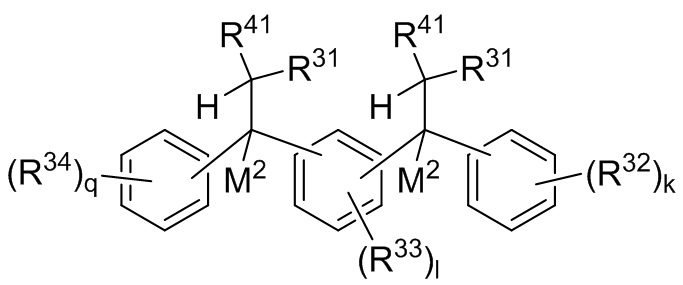 Formula 9a,
Formula 9a,
where each R31 is independently selected from hydrogen, (C1-C10)alkyl, (C6-C12)aryl and (C7-C18) aralkyl; each R32, R33 and R34 is independently selected from hydrogen, (C1-C18) alkyl and (C1-C18) alkoxy; each R41 is independently selected from (C1-C100) alkyl and (C2-C100) alkenyl, where each R41 optionally substituted with one to three (C6-C12) with aryl groups and optionally linked to a structure of Formula 9a through an oligomer chain consisting of up to 25 monomer links selected from conjugated dienes, especially 1,3-butadiene and isoprene, and aromatic vinyl compounds, especially styrene and divinylbenzene; each M2 is independently selected from lithium, sodium and potassium; and k, l and q are integers selected from 0, 1, 2 and 3; A1, A2 and A3 are independently selected from following Formula 3 to Formula 8:
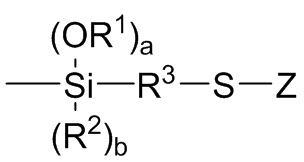 Formula 3,
Formula 3,
where each R1 is independently selected from (C1-C16) alkyl; each R2 is independently selected from (C1-C16) alkyl, (C6-C18) aryl and (C7-C18) aralkyl; a and b are integers independently selected from 0, 1 and 2, wherein a + b = 2; R3 is independently selected from divalent (C1-C16) alkyl, divalent (C6-C18) aryl, divalent (C7-C18) aralkyl and -R4-OR5-, where R4 and R5 are independently selected from divalent (C1-C6) alkyl; and Z is independently selected from (C1-C16) alkyl, (C6-C18) aryl, (C7-C18) aralkyl, (C=S)-SR6, where R6 is selected from (C1-C16) alkyl, (C6-C18) aryl and (C7-C18) aralkyl, and M1(R7)c(R8)d, where M1 is silicon or tin, each R7 is independently selected from (C1-C16) alkyl, (C6-C18) aryl and (C7-C18) aralkyl; each R8 is independently selected from -SR3-Si(OR1)r(R2)s, where R1, R2 and R3 are as defined for Formula 3 above, r is an integer independently selected from 1, 2 and 3 and s is an integer independently selected from 0, 1 and 2, wherein r + s = 3; c is an integer independently selected from 2 and 3; d is an integer independently selected from 0 and 1; and c + d = 3;
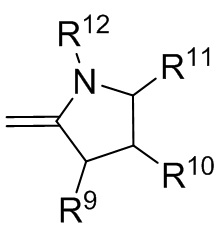 Formula 4
Formula 4
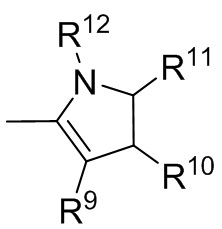 Formula 5, where R9, R10, R11 and R12 are independently selected from hydrogen, (C1-C16) alkyl, (C6-C16) aryl and (C7-C16) aralkyl;
Formula 5, where R9, R10, R11 and R12 are independently selected from hydrogen, (C1-C16) alkyl, (C6-C16) aryl and (C7-C16) aralkyl;
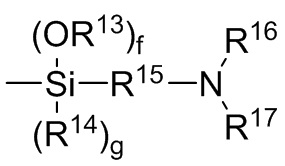 Formula 6
Formula 6
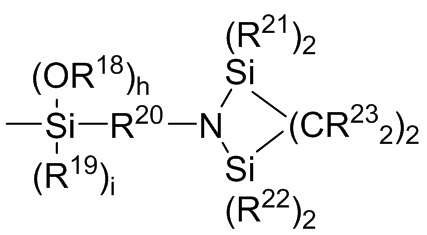 Formula 7,
Formula 7,
where each R13, R14, R18 and R19 is independently selected from (C1-C16)alkyl; R15 and R20 are independently selected from divalent (C1-C16) alkyl, divalent (C6-C18) aryl, divalent (C7-C18)aralkyl and -R24-OR25-, where R24 and R25 are independently selected from divalent (C1-C6) alkyl; R16 and R17 are independently selected from (C1-C16) alkyl and -SiR26R27R28, where R26, R27 and R28 are independently selected from (C1-C16) alkyl, (C6-C18) aryl and (C7-C18) aralkyl; each R21 and R22 is independently selected from (C1-C16) alkyl, (C6-C18) aryl and (C7-C18) aralkyl; each R23 is independently selected from hydrogen and (C1-C6) alkyl; f, g, h and i are integers independently selected from 0, 1 and 2; f + g = 2; and h + i = 2;
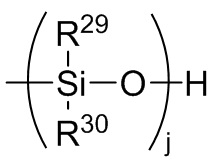 Formula 8,
Formula 8,
where each R29 and R30 is independently selected from (C1-C16) alkyl, (C6-C18) aryl, (C7-C18) aralkyl and vinyl; and j is an integer selected from 1 to 200; and wherein amount of polymer of Formula 1 ranges from 15 to 85 % in moles based on total amount of polymer of Formula 1 and polymer of Formula 2. Also described is a method of producing a polymer composition and a crosslinked polymer composition.
EFFECT: technical result is improved dynamic properties of cross-linked rubber compounds.
21 cl, 1 dwg, 9 tbl, 43 ex
| Title | Year | Author | Number |
|---|---|---|---|
| POLYMERISATION INITIATORS | 2013 |
|
RU2666359C2 |
| TIRE FOR WHEELS OF VEHICLES | 2017 |
|
RU2731944C2 |
| AMINOSILANE-MODIFIED POLYMERS | 2012 |
|
RU2609166C2 |
| MIXTURE OF FUNCTIONALISED POLYMERS FOR TIRES | 2016 |
|
RU2716689C2 |
| SILANE-SULFIDE MODIFIED ELASTOMERIC POLYMERS | 2012 |
|
RU2617403C2 |
| MODIFIED ELASTOMERIC COPOLYMERS WITH LOW CONTENT OF VINYL CONNECTIONS | 2013 |
|
RU2661220C2 |
| MODIFIED POLYMER COMPOSITIONS | 2010 |
|
RU2558597C2 |
| MODIFIED ELASTOMERIC POLYMERS | 2009 |
|
RU2504555C2 |
| MODIFIED POLYMER COMPOSITIONS | 2012 |
|
RU2599723C2 |
| RUBBER MIXTURE | 2012 |
|
RU2612148C2 |
Authors
Dates
2019-10-01—Published
2015-12-30—Filed